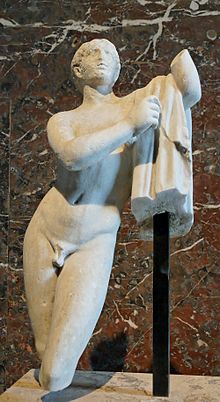Pothos (mythology)
Pothos (Ancient Greek Πόθος "desire") in Greek mythology is the personification of longing for an absent object and, to that extent, of grief.
Pothos does not belong to the early daimones and gods of Greek mythology. Homer and Hesiod do not know him. In Homer, the word pothos mostly expresses the desire of a horse for its absent owner, in the case of Automedon, for example, for his death. Whether pothos is already intended as a personification in the poet Archilochos, who wrote poetry in the 7th century BC - he calls the limb-releasing (lysimelés) pothos "my friend" - remains uncertain. The limb-solving Pothos is also attested by his contemporary Alkman in the Astymeloisa partheneion, which was only discovered in the 1950s. It is only from the 5th century BC onwards that it appears more frequently and can be traced in poetry, philosophy and the visual arts.
In the tragedy The Protectors of Aeschylus, performed between 465 and 460 BC, Pothos appears for the first time as a personification. There he was the son of Aphrodite. The fabulist Babrios also names Aphrodite as mother about 100 A.D., but with him Pothos has become several Pothoi. In Alkaios Iris and Zephyros are the parents of Eros, and following this tradition the Nonnos of Panopolis, writing in the 5th century AD, still names Iris as the mother also of Pothos in his Dionysiaka. While Plato makes him the son of Eros in the Symposion, according to Philon of Byblos, the Phoinians considered Eros and Pothos to be the sons of Kronos and Astarte, and thus brothers.
Regardless of the exact relationship, Pothos was closely connected with Eros and Himeros, the personification of the desire for love. While Eros and Himeros already appear together in Hesiod's Theogony and appear with the birth of Aphrodite, Pothos joins them only later. Plato, in his dialogue Kratylos, explains the relationship of the three to each other by describing them as three states of thymos, a person's state of mind, saying that Pothos is the desire for something absent, Eros and Himeros, in contrast, the desire for something present. The difference between the latter would be that Himeros arises from the person himself, whereas Eros is only triggered by the object of desire and therefore from outside. With the Stoics, Pothos is, along with Eros and Aphrodite, one of the powers that rule over the πάθη, the passion.
In Alexandrian times, from Meleagros of Gadara onwards, there is no longer a clear distinction between Eros and Pothos, and Pothos can also be given as a name for Eros.
In myth, Pothos, along with Eros, Himeros, Hymenaios and the Charites, but also appearing in other combinations, was one of the companions Aphrodite gave to Paris to woo Helen.
Pausanias, in his description of the temple of Aphrodite at Megara, mentions a group of statues from the hand of Skopas: "From Skopas come Eros, Himeros, and Pothos, if their actions are as different as their names." Tentatively linking a type of statue known in several Roman replicas to the Pothos of Skopas, who was one of the best known sculptors of the 4th century BC.
Pothos is frequently encountered in Greek vase painting, where he is identified by name inscriptions. Mostly they are Dionysian scenes in which he blows the auloi or strikes the tympanum. In an Attic red-figure vase by the Kadmos painter, made around 400 BC, he brings sandals to Eurynoe, while Eros brings fruit to the Hippodame, all in the presence of Iaso and Asteria. Other vase paintings show Pothos as present at the Judgment of Paris or alone with Helena. He is often depicted winged and has no independent iconography compared to Eros, so that in the case of other vase pictures without inscriptions of names it is not possible to decide who is depicted.
The relationship of Pothos as the personification of longing, sorrow and sweet desire is also evident from a plant called Pothos, which was planted on graves as a "flower of longing".

Roman copy of a statue of Pothos after Skopas (?)

Eurynoe, Pothos, Hippodame, Eros, Iaso and an Asteria on an Attic red-figure vase by the Kadmos painter, c. 400 BC.
Search within the encyclopedia